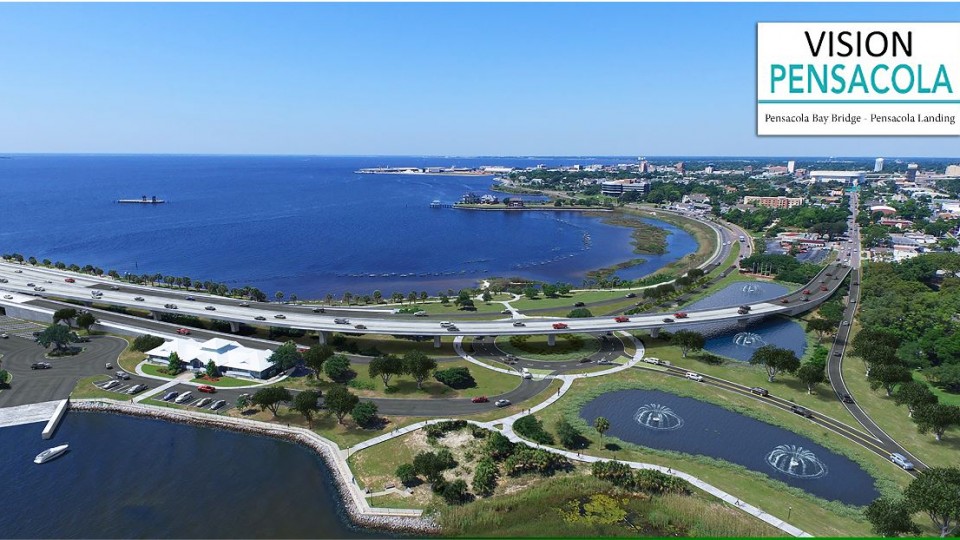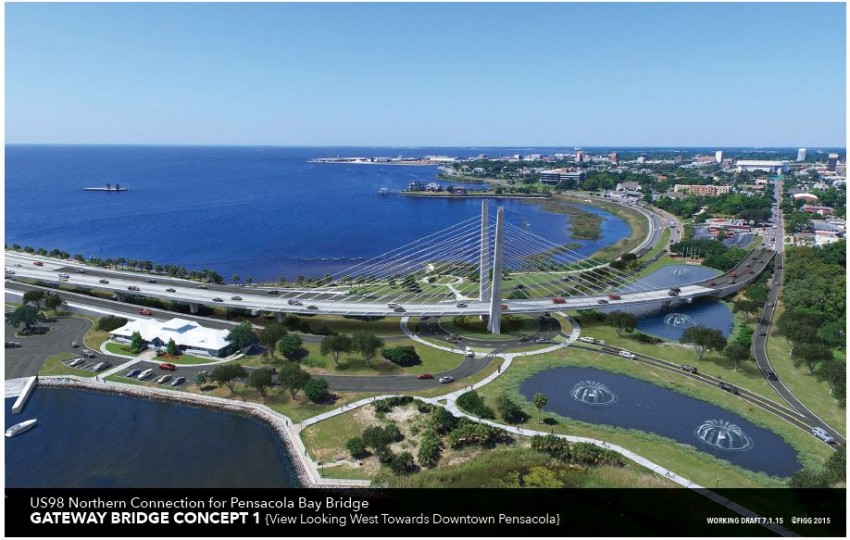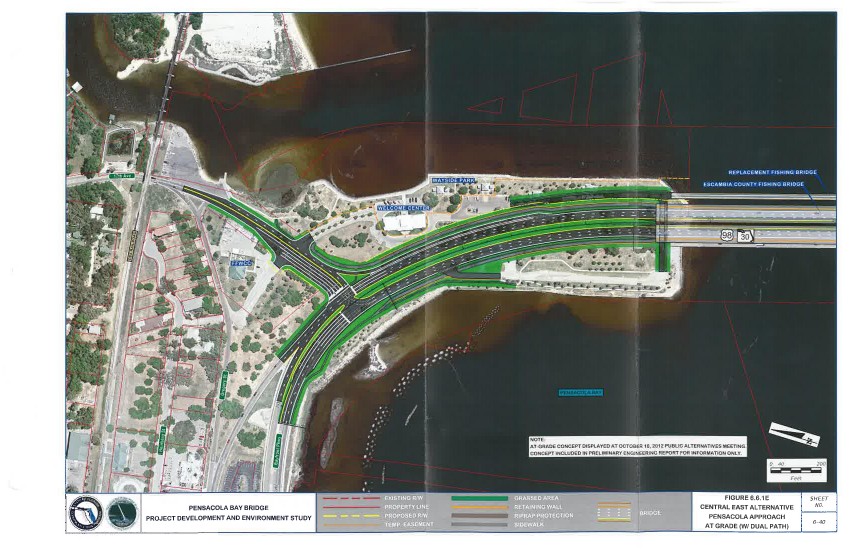Pensacola bridge landing plan could take small steps
- November 2, 2015
- / Shannon Nickinson
- / community-dashboard

On Nov. 3, a plan to build a gateway landing for the new Pensacola Bay Bridge could take an incremental step forward.
It is one of many such steps that supporters of the idea — who are working at the grassroots levels as Vision Pensacola — will have to go through to get their proposed project on the list that Florida Department of Transportation officials swear by when it comes to infrastructure spending.
It will come at a meeting of the Florida-Alabama Transportation Planning Organization in Pensacola. The meeting includes the approval of the 2040 long range transportation plan cost feasible plan — the list of transportation projects that the TPO thinks it is financially feasible to prioritize for the given time frame.
It is Vision Pensacola’s goal to get the enhanced landing project on that list.
“It’s an important part of assigning the project a status,” said Alan Gray, president of First City Development Group, who with Steve Dana of Jerry Pate Designs, has been promoting the vision of the improved bridge landing project.
Gray says estimates based on data Vision Pensacola received from FDOT indicate the project would cost between $18 million and $22 million.
But a price tag won’t be attached to the concept until the project development and environmental study of the intersection is completed, Gray says.
“This helps Santa Rosa and Escambia,” Gray says. “This is a huge project for both counties.”
In October, members of the Florida-Alabama Transportation Planning Organization approved a FDOT plan to spend $215,000 on a project development and environmental study of that intersection.
The study’s focus is to determine what can and cannot be done — environmentally and from a cost-benefit standpoint — at the Bayfront Parkway-17th Avenue intersection. That process will begin in early 2016, says Ian Satter, DOT spokesman.
Traffic count on U.S. 98 in that area now, according to DOT spokesman Ian Satter:
The Pensacola Bay Bridge alone sees 53,000 cars a day.
— There are 16,000 cars on 17th Avenue a day.
— Bayfront Parkway sees 14,000 cars a day.
— Chase Street sees 15,000 cars a day.
— Gregory Street sees 17,000 cars a day.
Satter said technical proposals for the bridge project are due in May 2016. Bid opening is scheduled for July 2016. Work is expected to begin in late 2016 to early 2017, Satter says, with construction likely to take three to four years.
The TPO also approved a contract addendum that provides a $15 million “no excuse” incentive bonus to the general contractor if the southbound portion of the new bridge is completed within 860 days from start of construction.
For the bonus to take effect the southbound portion of the parallel bridges would have to accommodate both south and northbound traffic from the old Pensacola Bay Bridge until the new bridge’s northbound lanes are completed and accepting all traffic.
An alternate landing idea
Vision Pensacola supporters pitch the idea — which creates a roundabout for local traffic using 17th Avenue and Bayfront Parkway and a flyover to bring bridge traffic onto Gregory Street — as an aesthetic and emergency preparedness improvement over the current DOT design for the bridge.
Vision Pensacola's alternatives:

This is one of the concepts that Vision Pensacola proposes to improve the intersection at Bayfront Parkway and 17th Avenue for the new Pensacola Bay Bridge. Photo credit: Vision Pensacola.
Advocates say the alternative designs improve the community’s resilience in a hurricane or large storm and will accommodate future growth better.
“This is a separate project,” Gray stressed from the main bridge replacement project. “Our charge is to go find the money within our (DOT) district. Now we are trying to show that this is a critical step.”
Getting the landing project on the cost feasible list is part of making sure “all the right the boxes are checked,” Gray says.
It also will mean making the persuasive argument that other projects in the district that may already be on the cost feasible list can be delayed two years or so to move the bridge landing project up the priority list, Gray says.
As Gray and Dana made the rounds at civic groups and TPO and other local government meetings to gauge and garner support for the project, concerns arose that an insistence on tying the new landing design to the main bridge replacement project would delay the critical project.
State Sen. Don Gaetz, who secured the funding for the bridge replacement project has noted that delaying the main project would put that money at risk.
“We expect bids to back in such a fashion that dirt can fly by November 2016,” Gaetz says. “That’s as special day for me because I go out of office. My view is that it will be more difficult for us to get a half billion dollars in funding in the future than it has been in the recent past.”
Keeping bridge replacement on track
It was Gaetz’s priority to get the bridge project funded without a toll — something common for projects elsewhere in the state but something he says could put a hurt on the economy of the Pensacola area.
“We were able to get this money because when I was Senate president, the Department of Transportation came to me and said Mr. President, we need you to sign off on a major project in Central Florida,” Gaetz says. “And I said, as I thumbed through the project, ‘I don’t see anything in here for Northwest Florida.’ So I said, and I don’t apologize for being parochial, until there is some equity in this plan, I’m afraid you won’t get my signature.”
“If we have to go back through the legislative process, I can’t guarantee that those who are signing off on that process now, who are presiding officers from Central Florida, friends of mine, good public servants, but strong proponents for their own areas, I can’t guarantee that they will sign off on carving out $500 million for the Pensacola bridge without a toll,” Gaetz says.
“The least risky alternative is take the appropriation we have, take the project that’s been approved without the big tower and landscaping and build it. And then do what we advised the Visit Pensacola people to do, to make their proposal for additional funding but let that project stand on its own. Let’s not hold a half-billion in transportation funding hostage to the desire for what may or may not be an interesting idea.”
Gray said that message was received and Vision Pensacola is proceeding accordingly.
“We completely understand what he’s saying,” Gray says. “We still have a project that’s viable. We still have a path to success, and we’re going after this project.”

 CivicCon launches with a look at good growth in cities
CivicCon launches with a look at good growth in cities
 Building stronger brains one baby, one parent at a time
Building stronger brains one baby, one parent at a time
 SCI debuts commercial on Early Learning City
SCI debuts commercial on Early Learning City
 Entrecon: World class speakers and an opportunity to sharpen skills
Entrecon: World class speakers and an opportunity to sharpen skills
 PYP Quality of Life survey 2017
PYP Quality of Life survey 2017
 EntreCon Pensacola 2016: A look back
EntreCon Pensacola 2016: A look back
 Leadership tip: getting better employee takeaways
Leadership tip: getting better employee takeaways
 Leadership tip: be interested instead of interesting
Leadership tip: be interested instead of interesting
 Leadership tip: delivering difficult messages
Leadership tip: delivering difficult messages
 Brain Bags boost Arc, Early Childhood Court programs
Brain Bags boost Arc, Early Childhood Court programs